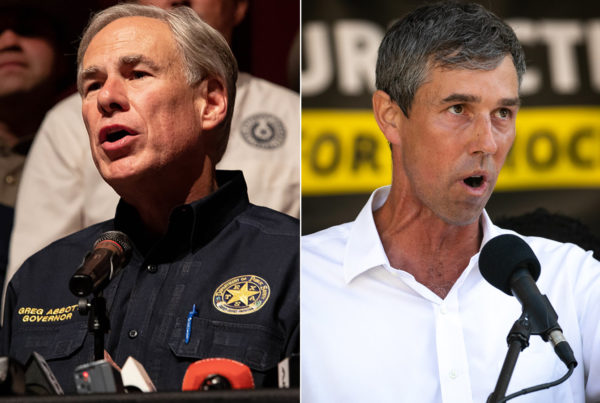The state of Texas has chartered buses to transport migrants to cities like New York, Chicago, and Washington, D.C., for months. The bus trips are part of the Gov. Greg Abbott administration’s strategy to expose what it believes is an unsecure border, that states like Texas bear the brunt of. Opponents say that they’re expensive political theater.
Sam González Kelly, a reporter for the Houston Chronicle, recently followed one such bus that took migrants from Eagle Pass to Chicago. He spoke to the Texas Standard about the trip. Listen to the story above or read the transcript below.
This transcript has been edited lightly for clarity:
Texas Standard: This is a fascinating undertaking that you and your photographer, what, started at a shelter for immigrants in Eagle Pass?
Sam González Kelly: Yeah. We spent two days hanging out at a shelter in Eagle Pass, just kind of waiting for a bus to leave because there’s not very much advance notice with these sort of things. So we just kind of drove down there hoping that we would have some good luck, and we did.
So you were mingling with some of the folks who would be passengers. Can you describe what the scene was like before people got on?
I would describe it mostly as one of confusion. You know, people knew that these buses to Chicago were going to be leaving at some point, but they had no idea when. And it never really seemed like a certain thing for anyone until they were actually physically on the bus. So we had a lot of people coming up and asking us like, “Is there a bus coming? When’s it leaving?” Questions like, “How far is it from Chicago to New York?”
How many of these migrants were going to Chicago and knew they were going to Chicago, versus perhaps confused about whether or not you could step away from the bus in Chicago and in a few miles be in New York? You know what I’m saying? Sort of a reality check there.
Right. Everyone was aware that they were going to Chicago. A lot of them did not have Chicago as their final destination, that’s for sure. And whether or not they had an idea of realistically how far away Chicago is from their final destination is another question. But yeah, you know, people would ask us “How far is it from Chicago to New York?” And we’d be like, “I’ve done that drive before; I think it’s like 14, 15 hours.” And they were like, “Well, better than, you know, from here to New York.” So that’s why they got on.
Tell us about the trip itself. What were you able to notice while tailing the bus?
Well, people weren’t being let off the bus at least while we were tailing for the first 10, 12 hours of the trip. And I was communicating with a man on the bus via WhatsApp who was saying that there are kids on the bus who really need to use the bathroom. Like “We just want to like buy a snack at the gas station” because the bus drivers were getting off. The bus would stop every couple of hours and bus drivers and security guards would get off at gas stations and rest stops, but migrants did not, at least while we were trailing.
And when they eventually did and our photographer was out there trying to take pictures of the scene, people hustled them back onto the bus and then they peeled off again. So that’s when we decided to, in the migrants’ best interests, kind of abandon the bus and just get out ahead of them.
What was the scene like when the bus finally arrived in Chicago?
It was jubilant, honestly. It was really something to see. People got off the bus and were just, I think, pretty thrilled for the 24-hour bus ride to be over. To be in like this big, beautiful new city, high-fiving police officers, high-fiving myself and my colleague, the one man reuniting with his two sons … Yeah, it was definitely something.
But I would imagine, landing in what for many must have been an unknown place, were there people there to meet them with resources? Where to go, where to stay overnight?
Yeah. And that was the other thing: They didn’t know that if anyone was going to be there. They were asking me on WhatsApp if there was going to be anyone there to to take them in. And I was like, “I’m pretty sure, but I can’t tell you for sure until we get there.” But the Chicago Police Department and Office of Emergency Management had people there, and they very quickly shuttled people from the first bus on to a local Chicago Transit Authority bus and took them to, I believe, a Salvation Army shelter. And the city of Chicago was super strict about media access inside those shelters, so we were not allowed in there.
After this experience that you witnessed, what was your takeaway as a reporter? What were you left with feeling?
I mean, at first just exhausted. But I don’t think it’s inaccurate to say that, you know, these small border communities are truly overwhelmed. You know, around Del Rio and Eagle Pass, it’s like tens of thousands of people every month crossing over. And these are small cities without the infrastructure or resources to support that the way the RGV might have, because it’s a more historically popular crossing point.
But I also understand the argument that this is a political stunt and that these conservative governors are using these people as pawns, even if they are, at the end of the day, giving them a free ride to somewhere that they might want to go. That’s kind of the reason why we wanted to do the story this way and focus more on the experiences of the people involved, rather than whatever Greg Abbott or [Chicago Mayor] Lori Lightfoot might have to say about it.















